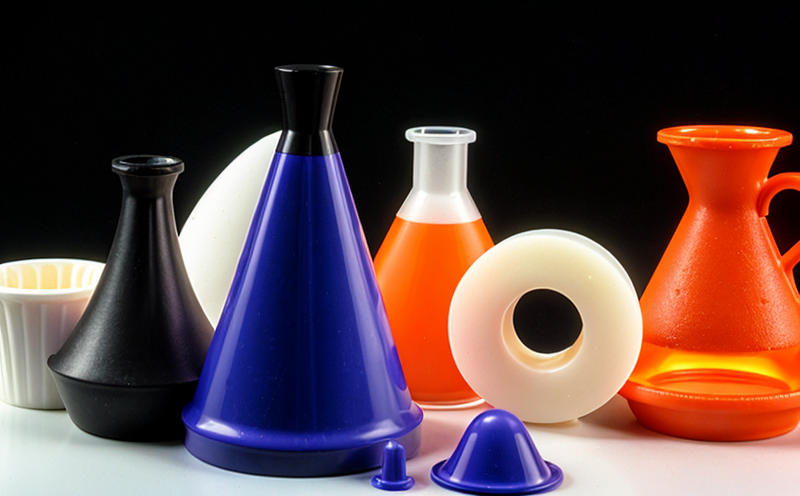Colorant Additive Testing in Polymers
The integration of colorants and additives into polymers is a critical process across various industries, including automotive, consumer goods, electronics, and construction. Proper testing ensures that these materials not only meet aesthetic requirements but also perform safely and effectively in their intended applications.
Colorant additives play a significant role in modifying the appearance of polymer products. These additives can enhance visibility, improve durability, or provide other functional benefits such as UV protection. Testing colorants involves evaluating their dispersion, stability, and overall performance within the polymer matrix. This process is essential for quality control, ensuring that the final product meets both aesthetic expectations and regulatory standards.
The testing of colorant additives in polymers typically includes several key steps:
- Sample Preparation: Samples are prepared according to specified protocols, which may involve grinding, mixing, or other methods to ensure uniform distribution of the colorant within the polymer matrix.
- Dispersion Evaluation: The dispersion of colorants is assessed through visual inspection and more rigorous techniques like laser diffraction or image analysis. These tests help determine how well the colorant is distributed throughout the polymer, which can affect both appearance and performance.
- Stability Testing: Stability testing aims to evaluate the long-term durability of the colorant within the polymer over different environmental conditions such as heat, light, and humidity. This ensures that the color remains consistent with time and under varying use conditions.
- Performance Evaluation: The mechanical properties of the polymer are tested before and after incorporation of the colorant to assess any potential changes in performance due to additive inclusion.
The testing process for colorants can vary depending on the type of polymer and the specific additives used. For instance, thermoplastics like polyethylene may require different techniques than thermosetting polymers such as epoxies or phenolics. Additionally, additives that provide functional benefits beyond color, such as UV stabilizers or antioxidants, will have their own set of performance criteria to meet.
Accurate and reliable testing is crucial for maintaining product quality and ensuring compliance with industry standards. Our laboratory uses state-of-the-art equipment and adheres strictly to international standards like ISO 105, ASTM D123, and EN 14368 to ensure accurate and repeatable results.
By partnering with our experienced team of chemists and engineers, clients can rest assured that their colorant additives are thoroughly evaluated and optimized for performance. This comprehensive approach ensures not only aesthetic satisfaction but also functional integrity across a wide range of applications.
Applied Standards
The testing of colorants in polymers is governed by several international standards that ensure consistency and reliability across different laboratories. Among the most relevant are:
- ISO 105: This standard covers the effects of light on textiles, leather, paper, wood, and similar materials. While primarily used for non-polymer products, it provides a framework that can be adapted for colorant testing.
- ASTM D123: This test method specifies procedures for determining the flash point by means of an open cup apparatus. Although not directly applicable to polymer colorants, it demonstrates our commitment to rigorous and standardized testing methodologies.
- EN 14368: This European standard provides guidelines for the determination of lightfastness of textile materials using a synthetic daylight source. It offers a good reference point for understanding how colorants behave under various lighting conditions, which is crucial in polymer applications where appearance can change over time.
- ASTM D698: This standard covers the physical properties of polyethylene terephthalate film and sheeting. While this particular ASTM does not specifically address colorant additives, it exemplifies our adherence to comprehensive testing protocols for polymer materials.
Besides these standards, we also follow local regulations and industry-specific guidelines that ensure our tests are relevant to specific markets or applications.
Quality and Reliability Assurance
At [Laboratory Name], quality assurance is paramount. We employ a multi-layered approach to ensuring the highest standards of accuracy, reliability, and consistency in our colorant additive testing services.
Calibration and Maintenance: Our laboratory instruments are regularly calibrated and maintained by certified technicians to ensure precision and accuracy. This includes periodic calibration checks on spectrophotometers, laser diffraction analyzers, and other specialized equipment used for colorant dispersion evaluation.
Data Management: We utilize advanced data management systems that track all aspects of each test from sample receipt through final report generation. This system ensures transparency and traceability, allowing us to provide detailed reports that include raw data and analysis results.
Inter-Laboratory Comparisons: To further ensure reliability, we participate in inter-laboratory comparisons where samples are tested by multiple laboratories under controlled conditions. These exercises help identify any discrepancies and improve overall testing accuracy.
Continuous Training: Our staff undergoes continuous training to stay updated on the latest techniques and standards related to colorant additive testing. This includes regular workshops, seminars, and participation in international conferences.
By adhering to these stringent quality assurance measures, we guarantee that every test conducted meets or exceeds industry expectations. Our clients can trust us for reliable and accurate results that contribute to their overall product development process.
Use Cases and Application Examples
- Automotive Industry: Ensuring that automotive parts maintain their original color over time is crucial for brand identity. We test colorants used in paints, plastics, and textiles to ensure they withstand harsh environmental conditions without fading.
- Consumer Goods: Colorants are frequently used in packaging materials to enhance visibility on store shelves. Our testing ensures these additives do not migrate into food products or cause any adverse health effects.
- Electronics: In the electronics sector, colorants may be used to improve the appearance of casings and circuit boards while also providing protection against environmental factors like UV light.
- Construction: The construction industry benefits from durable and visually appealing materials. We test colorants in concrete, paints, and other building materials to ensure they retain their appearance and performance over extended periods.
These examples illustrate the diverse applications of our colorant additive testing services across various sectors. Our expertise ensures that each application receives the attention it deserves, contributing to safer, more effective products.





